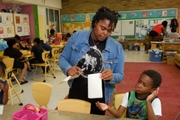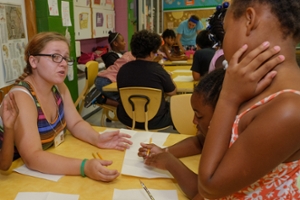Reframe Podcast: Episode 18

Urban Cohort Inspires Radical Empathy and Social Change

In this episode, we explore the inner workings of the Urban Cohort, an action-oriented program that exposes college students to urban perspectives through high-need schools and community organizations. Here, experiential learning is grounded in community life in very real ways.
James Loy:
This is Reframe, The podcast from the College of Education, Health and Society on the campus of Miami university.
In this episode, we explore the interworking of the Urban Cohort, an action-oriented program that exposes college students to urban perspectives through high-need schools and community organizations. Here, experiential learning is grounded in community life in very real ways.
(Music Fade)
Asthma was a big problem in their urban Cincinnati neighborhood. It impacted their friends, their family members, and many of those they loved. So a group of local student mentors, and their Miami University mentee, decided to make an impact.
They took steps to learn what caused asthma, and how the roaches and mold responsible are often present in low income housing. They cross-referenced city-wide asthma rates with area zip codes to identify correlations between asthma, poverty, and disproportionally affected minorities.
They even combed through lease agreements and wrote scripts, which were used to interview and urge leasing agencies to fix inferior housing conditions. Then they developed informational booklets to distribute at an outdoor health fair and encouraged local residents to put rent payments in escrow if housing conditions were not improved.
And after connecting with Cincinnati Children’s Hospital’s asthma team, these Rothenberg Preparatory Academy 4th graders also met with an advisory committee, where one student mentor was hired on as a consultant who . . .
Wait. These were 4th graders?
Yes.
Let’s back up.
These Rothenberg 4th graders were part of the Urban Cohort, an award-winning action-oriented and highly collaborative partnership between Miami University’s College of Education, Health and Society, urban schools, and civically-minded community organizations.
Today, the program operates primarily in Cincinnati’s Over-the-Rhine (OTR) neighborhood where issues such as poverty, inequality, race, and gentrification all take center stage as participants gain a first-hand look at the lives and lived-experiences that often diverge greatly from their own.
The cohort was originally designed to prepare students to teach in urban areas. And though teacher education majors are still highly involved, the critical awareness the Urban Cohort offers is now starting to attract attention from students across all majors.
The Miami students who participate don’t just learn about various social problems affecting marginalized areas, they literally become part of these communities.
According to Dr. Tammy Schwarz, Urban Cohort Director, the genuinely immersive experience is fundamentally grounded in the day-to-day challenges that real resident face.
Tammy Schwartz:
If you ask a lot of folks, “What is really important to teaching?” I say it is the capital R. It is relationships, and you can’t do that when you are not in the space, when your body is not next to the person with whom you need to be building a relationship, when your body is not in the space of the neighborhood, walking the sidewalks that the children who go to school in that neighborhood use, or being in those places where families have to connect to services, or the grocery store.
James Loy:
The program unfolds over a three-year timeline and features four components: A preparatory course, experiential learning, reflection, and a culminating course. And throughout it, college students will also work directly with long-time residents and professional program collaborators, and many will eventually live and work in the neighborhood too.
During the first year, the preparatory course is grounded in systemic injustice. Here, the students deconstruct their own personal perspectives and learn how many social systems are created to benefit some people but not others. Then they’ll pair up with a youth in a local urban elementary school who will serve as their mentor.
Here’s Dr. Schwartz again:
Tammy Schwartz:
So we’ve flipped that. Miami students are not being a mentor to the “young” kid. The kid is being a mentor to the Miami student. The child is. So they have got the life experiences to bring credible assets to the table. And over the course of that year, our Miami students, the mentees, work with their mentors in collaborative groups doing action research on issues that the kids have identified that impact their lives.
James Loy:
This process directly informs the projects and curriculum-based learning that the Miami teacher education college students will subsequently design. Some years, these projects might center around homelessness, for example. Other projects have focused on violence and another reoccurring theme is economic inequality, which can be manifested in numerous ways including, even, the way the conditions of some low income housing can lead to increased asthma rates.
Tammy Schwartz:
And at the same time, our teacher candidates are now witnessing what curriculum can look like when its centered around what’s important to youth in their lives. So I am not giving you a work sheet on the statistics of homelessness in Cincinnati. You are investigating the statistics using resources that adults would use in order to investigate those issues. That now becomes your text. So showing our students that they can do curriculum in a different way.
James Loy:
So, then, when the 4th grade Rothenberg Elementary students first identified asthma as a concern in their lives, it was Miami student Anna Hartman who then figured out how the project would subsequently unfold.
Understanding the causes of asthma became science lessons. Comprehending the lease agreements became reading lessons. Analyzing and correlating city zip codes with asthma rates became math lessons, and so on.
This process is key, and it’s crucial to the learning and development of everyone involved.
For college students like Hartman, it opens their eyes to the many underlying and often hidden systemic problems that can perpetuate cycles of injustice and inequality.
For the elementary kids themselves, it proves that they too have a voice. That hey too can make a real difference in their own communities.
Tammy Schwartz:
Some people say we empower youth. I do not believe that. Youth already come to the table with a lot of power. So we don’t empower people. We are creating spaces for that power to be enacted.
James Loy:
While the Urban Cohort may currently still work primarily with teacher education college students, it is quickly becoming far more interdisciplinary, which is actually more in line with the program’s overall and original mission. In fact, one of Schwartz’s long-time program collaborators was Tom Dutton, the founder of Miami’s OTR-based Center of Community Engagement and a Miami professor of architecture.
Tammy Schwartz:
People would ask, “How does an architect person get connected up with a teacher education person?” There was always that “huh?” And Tom and I would have these conversations, and he said to me once, “Tammy, I really care about helping to develop a really good architect. But more importantly, I care about helping to develop really great human beings who care about those whose voices are not often heard in our society.” And that is exactly how I feel about teachers.
James Loy:
So throughout their tenure in the program, Miami students go through what Schwartz calls “deep heart work.” And it’s the type of work that can imbue a learning experience and, potentially even entire future careers, with more purpose and meaning, which is actually becoming more and more attractive to students across most majors today.
According to a recent study from UCLA, titled “The American Freshman,” most incoming freshman are primed to find greater meaning from the subjects they study and they also want to give back in some way.
Sara Williams:
They are driven toward something that . . . they might not use the term social justice, but something that would give meaning toward the academic or professional exercises they are engaging in. So I don’t think Miami students are any different than university students nationwide in that regard.
James Loy:
That’s Sara Williams, Miami University Adjunct Instructor and Emory University Ph.D. Candidate, who work also works alongside Schwartz within the program. And she says that Miami students also harbor this desire to give back and do meaningful work. They’re not any different than other students highlighted in the UCLA study.
So the idea then is to help develop students who are community-based practitioners, to facilitate this transformation. And it’s not just for those who want to become teachers. Regardless of major, it’s about but developing socially conscious individuals across all fields and professions.
Sara Williams:
So developing community accountants and community social workers and community graphic designers who don’t see their work in a silo. But see it as rippling out and impacting the ecosystem of the community in which they are situated.
Tammy Schwartz:
Yea. Well said. Well said.
James Loy:
Because of Tom Dutton’s original influence, the majority of these interdisciplinary participants, so far, have had an architectural background. But throughout the cohort’s eight-year history, the program has also welcomed students from speech pathology, public health, and business. This fall, students from marketing, public administration, social work, psychology, and journalism will participate as well.
Tammy Schwartz:
It is complex work, to reflect upon their own personal histories and how the system has positioned them to think about the world in particular ways, and to think about themselves in particular ways, and in ways that can be harmful. How then do they use that knowledge to fight back against that, in whatever their profession is going to be?
James Loy:
And Schwartz only expects this growing interdisciplinary interest to expand, especially as more students realize that the Urban Cohort opens the door to more meaningful and productive conversations around race, class, privilege, and power, and provides the opportunity to take real action as a result.

